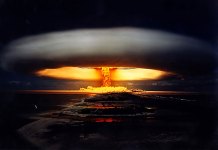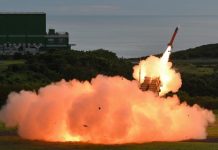Iran President Hassan Rouhani, much like the leaders of other countries has his eyes hooked to the television screens to learn the outcome of the US Presidential Elections 2020, probably praying that President Donald Trump loses out to Joe Biden in order to “make Iran great again”.
President Trump has for long remained a thorn in Tehran’s path to development ever since his decision to unilaterally withdraw from the Iran nuclear deal in 2018, following which Tehran has been repeatedly battered by a series of sanctions imposed by Washington which have led to its stunted growth.
However, much like adversity creating opportunity, while Iran has seen restrictions on the import and export of defense equipment, it has found the power within itself to enhance its defensive capabilities especially in the field of drone technology.
Recently, Iran has unveiled its newest attack Mohajer-6 Drone, which is a 10-feet-long jet-powered unmanned aerial vehicle (UAV) called the Kian, which according to the state media has the capacity to carry 6 guided munitions.

According to Defense writer David Axe, the drone should not be judged on its simple appearance.
“With its simple shape and apparent fiberglass fuselage, the new UAV probably is unsophisticated. But even an unsophisticated drone can pose a danger to enemy forces if its user employs it the right way and in sufficient numbers,” said Axe.
The Kian was revealed at a ceremony in Tehran last year by the head of Iran’s air-defense force, Brigadier General Alireza Sabahifard.
“The Kian can fly more than 600 miles and climb to an altitude of 15,000 feet. It can carry out precision strikes against distant targets … far from Iran’s borders.” Said Sabahifard
Iran had earlier showed off a series of drones which included a UAV called Mobin, which can supposedly fly up to 45,000 feet high for 45 minutes, and has a warhead of 120 kilograms.
Another set of drones that were showcased by Iran were the “smart bombs” dubbed by the name of Yasin and Balaban, along with a news series of Qaem “optic bombs”.
According to Commander of Iranian army drones Brigadier General Hasannejad, the UAVs will be instrumental in safeguarding the countries boundaries from threats.
“With the deployment of these unmanned aerial vehicles, any threat to the Iranian borders and even beyond the borders, will be identified, tracked down and removed before it could even take form,” said Hasannejad.
According to Seth J. Frantzman, Executive Director of the Middle East Center for Reporting and Analysis, Iran has now become a superpower in drone making.
“I’ve argued Iran is a ‘drone superpower’ considering the expansion of its UAV arm in recent years,”
Iran began its drone program during the Iran-Iraq war with UAVs [Unmanned Aerial Vehicles] such as the Mohajer and Ababil series,”
Iran is very proud of its success in creating an indigenous drone industry and pioneering its own UAVs.”
Thomas Harding, a London-based journalist, while writing an editorial for the National News, explores how the country’s clampdown at the hands of the United States gave them the power to develop the technology of drones.
“Ironically, it is sanctions that forced Iran to develop its own successful drone industry mostly by reverse engineering equipment that it could buy on the open market or by other means. It has quickly found that drones are smart, relatively inexpensive and can carry out the work of hundreds of soldiers,”
Furthermore, it is a technology easily exported to its proxies allowing them to carry on Iran’s strategic aims with a degree of ‘plausible deniability’. Without a doubt, Iran has come a long way in producing drones that, while not the equal to US and Israeli counterparts, at least make it a serious and recognized player in unmanned warfare.” said Harding.
However, on one hand, Iran has been able to follow the likes of Turkey which is considered to be a drone superpower along with the likes of Israel, the US, and the UK, on the other hand, India has found itself lagging behind in the race for drone superpower status.
Having found itself in a region sandwiched between “Iron Brothers” China and Pakistan, New Delhi has seriously considered the idea of exploring the vast potential in the drone technology market.
However, while each of India’s armed forces services has its own UAV arms operational for the last two decades which has been supplemented by the indigenization of the sector by India’s DRDO, the technology has faced barriers due to drone regulations within the country.
“While the Defence Research and Development Organisation (DRDO) has been trying to indigenize these, the private sector UAV industry has been growing. Unfortunately, the evolution of technology has been restricted due to ambiguity in implementation of Drone Regulations promulgated by Airport Authority of India (AAI).” said Huma Siddiqui, while writing an editorial for the Financial Express.
The country which has lost so many Indian security personnel in the Jammu and Kashmir border cross-firing, have felt the need for higher automation in activities like the UAVs.




